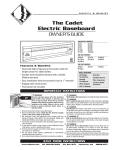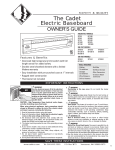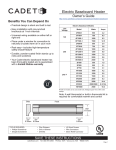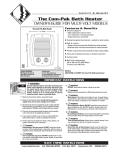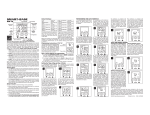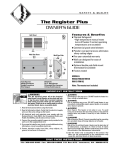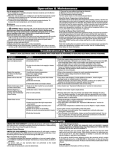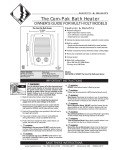Download Cadet 8F2500-8 Specifications
Transcript
The Cadet Electric Baseboard OWNER’S GUIDE 240 VOLT MODELS 2F350 6F1500 2F500 8F2000 3F750 8F2500 4F1000 10F2500 5F1250 Features & Benefits • • • • • Oversized high temperature limit switch with full length sensor for added safety Durable steel sheathed element with a limited lifetime warranty Easy installation with pre-punched case at 1” intervals Rugged steel construction Thermostat not included 208 VOLT MODELS 2F500-8 3F750-8 5F1250-8 6F1500-8 8F2500-8 4F1000-8 8F2000-8 120 VOLT MODELS 2F500-1 3F750-1 6F1500-1 4F1000-1 TOOLS REQUIRED • Phillips Screwdriver • Straight Screwdriver • Wire Strippers • Drill or Hammer Drill Bits (4) Wood Screws • (3) Wire Nuts • (1) Strain Relief Connector • • IMPORTANT INSTRUCTIONS 1. 2. 3. 4. 5. 6. 7. 8. WARNING! 9. WARNING Overheating or fire may occur. Do not install the heater behind doors. Turn the electrical power off at the electrical panel board (circuit breaker or fuse box) and 10. WARNING lock or tag the panel board door to prevent Fire or explosion may occur. Heater has hot and arcing or sparking someone from turning on power while you are parts inside. Do not install heater in any area where combustible working on the heater. Failure to do so could vapors, gases, liquids, or excessive lint or dust are present. result in serious electrical shock, burns, or 11. WARNING possible death. Burn Hazard. This heater is hot when in use. To avoid burns, do not let bare skin touch hot surfaces. Use extreme caution when Read all instructions before using this heater. any heater is used by or near children or invalids and whenever Read all information labels. Verify that the electrical supply the heater is left operating unattended. wires are the same voltage as the heater. All electrical work and materials must comply with the 12. WARNING Risk of electrical shock. Keep all foreign objects out of heater. National Electric Code (NEC), the Occupational Safety and Do not operate after heater malfunctions or has been dropped Health Act (OSHA), and all state and local codes. or damaged in any manner. The heater must be grounded to the grounding pigtail (copper wire) provided. 13. WARNING If you need to install a new circuit or need additional wiring Risk of Fire. Do not block heater. Heater must be kept clear of information, consult a qualified electrician. all obstructions: minimum of 12 inches in front and above, Protect electrical supply from kinks, sharp objects, oil, grease, 6 inches on both sides. Heaters must be kept clean of excessive hot surfaces or chemicals. lint, dirt and debris. (See Maintenance Instructions) Do not place heater against paperboard or low-density 14.Use this heater only as described in this manual. Any other use cellulose fiberboard surfaces. not recommended by the manufacturer may cause fire, electrical Do not place heater below an electrical convenience receptacle. shock, or injury to persons. SAVE THESE INSTRUCTIONS Tel: 360-693-2505 Fax: 360-694-8668 P.O. Box 1675 Vancouver, WA 98668-1675 READ ALL INSTRUCTIONS AND SAFETY INFORMATION. Installation Instructions PLACEMENT: For best results, install the baseboard heater under a window, along an outside wall, or as close as possible to an outside door. Do not install any baseboard below an electrical outlet. Horizontal mount only. THERMOSTAT: A thermostat is required. A Cadet wall thermostat is recommended for optimum performance, or you may prefer the convenience of a built-in thermostat kit. WARNING! RISK OF ELECTRICAL SHOCK. TURN OFF ALL POWER AT THE ELECTRICAL PANEL BOARD SUPPLYING POWER TO THE HEATER BEFORE DOING ANY ELECTRICAL WIRING. WARNING! Risk of Fire. Heater must be kept clear of all obstructions: 12“ in front and above; 6” on both sides minimum. IMPORTANT! It is extremely important that you verify the electrical supply wires are the same voltage as the heater (i.e. 120 volt heater to 120 volt power supply and 240 volt heater to 240 volt power supply). If replacing an existing heater, check the labels of the old heater and replace using the same voltage. Hooking a 240 volt heater to a 120 volt power supply will drastically reduce the heater’s output. Hooking a 120 volt heater to a 240 volt power supply will destroy the heater. STEP 1 Area of Installation STUDS • The seam at the junction of the wall and floor behind the heater should be caulked to prevent dust from being drawn into the room. • Heater should be set flush against surface of the wall. • When installing a baseboard heater, remove any obstructions between the back of the unit and the surface of the wall. • Baseboard heater may sit directly on any floor surface, including carpet. • Do not allow carpet to block lower air intake located 1 inch from the bottom. • Maintain at least 12 inches minimum clearance from objects hanging above (i.e., drapes). STEP 2 Mounting Heater to Wall 1. Locate wall studs closest to supply wires and position heater. NOTE: Wire connection is possible from either right or left side of the baseboard heater. 2. Remove the wiring compartment cover by removing the screw. The wiring compartment is an approved junction box for the baseboard only. No additional junction box is required. 3. Remove the slotted knockout closest to the supply wires and install a strain relief connector. WIRING COMPARTMENT COVER MOUNT SECURELY TO WALL Baseboard Wiring IMPORTANT! It is important that you verify the electrical supply wires are the same voltage as the heater. Check heater specifications to ensure correct wiring. Failure to do so may destroy the heater and void your warranty. 120 Volt Baseboard Wiring: 3 wire hookup – 1 hot, 1 neutral and 1 ground. 240 Volt Baseboard Wiring: 3 wire hookup – 2 hot, 1 ground (no neutral needed). STEP 3 Disconnect One Factory Connector Wire connection is possible from either left (A) or right (B) side of the baseboard heater. You must disconnect one factory connector on the side you are wiring, but do not disconnect both. (See Figure 3). A Figure 1 DO NOT DISCONNECT NOTE: You do not need to remove the element, cover or deflector to mount the heater. 6. Connect the grounding lead to the grounding pigtail (copper wire) with a connector. It may be necessary to move ground lead to the side you are wiring. B GROUND Figure 3 4. Pull supply wires through the connector and secure leaving 6 inch wire leads for later use. 5. Mount the heater securely to the wall with nails or screws going into at least two wall studs (See Figure 2). The back of the heater has “star punch” dimples that allow nails or screws to easily pierce the sheet metal. Figure 2 Proceed to Step 4. Installation Instructions STEP 4 Baseboard Wiring to a Wall Thermostat Refer to the wiring diagram below that corresponds to your heater and thermostat application. Note: Wiring diagrams shown below are for reference only. All wiring must comply with the National Electric Code (NEC). See wall thermostat instructions for your specific application. BASEBOARD WIRING WITH A SINGLE POLE (2 WIRE) WALL THERMOSTAT - 120V OR 240V SUPPLY (See Figure 4) BASEBOARD WIRING WITH A DOUBLE POLE (4 WIRE) WALL THERMOSTAT - 120V OR 240V SUPPLY (See Figure 5) 1. After you have disconnected factory connector A (left side) or factory connector B (right side), proceed to the next step. 2. Route supply wires to the thermostat wiring box. 3. Connect one supply wire to one thermostat wire (typically marked L1). 4. Connect remaining thermostat wire (typically marked T1) to one heater wire. 5. Connect remaining supply wire to remaining heater wire. 6. Connect supply ground to grounding pigtail provided. 1. After you have disconnected splice A (left side) or splice B (right side), proceed to the next step. 2. Route supply wires to the thermostat wiring box. 3. Connect one supply wire to one thermostat wire (typically marked L1). 4. Connect remaining supply wire to one thermostat wire (typically marked L2) 5. Connect one thermostat wire (typically marked T1) to one heater wire. 6. Connect remaining thermostat wire (typically marked T2) to remaining heater wire. 7. Connect supply ground to grounding pigtail provided. To Supply L1 Thermostat wiring box LOW Single Pole Thermostat Figure 4 Left Side Wiring Shown To Supply L1 Thermostat wiring box OFF T1 T1 Baseboard Heater Figure 5 Left Side Wiring Shown L2 T2 Double Pole Thermostat Baseboard Heater Side ‘A’ Shown Side ‘A’ Shown Multiple Baseboard Wiring - Optional More than one baseboard heater can be wired in parallel on same circuit (Be sure to check national and local codes for safety requirements). Follow these instructions if you are wiring more than one heater in parallel on same circuit. Wiring diagram shown below is for reference only. All wiring must comply with the National Electric Code (NEC). See wall thermostat instructions to determine which thermostat wires are appropriate for supply and which for heater. MULTIPLE BASEBOARD WIRING 240V SUPPLY ONLY 1. Left side wiring: disconnect A. Right side wiring: disconnect B. 2. Connect one wire from each heater to one supply wire. 3. Connect remaining wire from each heater to the remaining supply wire. 4. Connect supply ground wire to both ground leads. Figure 6 To Supply B Heater Wires A Field Wiring Ground Do not disconnect For instructions on wiring using an in-built thermostat, see Cadet BTF1, BTF2 and SBFT2 Installation Instructions Operation & Maintenance How To Operate Your Heater Maintenance 1. Switch the power on at the electrical panel board. PLEASE NOTE: Upon initial start-up, the heater may emit a burning odor. This is not dangerous, and is due to a protective lubricant used during the manufacturing process. It typically dissipates within several hours. 2. Turn the thermostat fully clockwise. 3. When the room reaches your comfort level, turn the thermostat knob counterclockwise until a clicking sound is heard (if using a digital thermostat, set at desired room temperature). The baseboard will automatically cycle around this preset temperature. Cadet electric baseboards are virtually maintenance-free. However, a certain amount of lint and dust will accumulate inside the unit and should be periodically cleaned: 1. Turn the electrical power off at the electrical panel board (circuit breaker or fuse box) and lock or tag the panel board door to prevent someone from turning on power while you are working on the heater. Failure to do so could result in serious electrical shock, burns, or possible death. 2. Vacuum inside the unit, being careful not to damage the aluminum fins on the heat exchanger. Troubleshooting Chart CONSULT LOCAL ELECTRICAL CODES TO DETERMINE WHAT WORK MUST BE PERFORMED BY QUALIFIED ELECTRICAL SERVICE PERSONNEL Symptom Problem Solution 1. Unit may have a loose end plate 2. Heater may not be mounted properly 1. Loosen end plate screws ¼ turn after allowing heater to warm, move end plate back and forth, then tighten 2. Loosen heater from wall by turning mounting screws ¼ turn Heater not working 1. Heater does not have proper voltage to function correctly 2. Loose wire connections 3. Incorrect circuit breaker 4. Defective limit 1. Check voltage at the heater between supply wires and make sure it matches required heater voltage 2. Tighten any loose wire connections 3. Circuit breaker positioned incorrectly - relocate breaker 4. Limit defective - replace limit Heater will not shut off 1. Heat loss from room is greater than heater capacity 2. Defective thermostat 1. Close doors and windows. Provide additional insulation, install a higherwattage heater or multiple heaters if necessary 2. Adjust thermostat to its lowest setting. If heater continues to run (allow two minutes for the thermostat to respond), replace thermostat 3. Refer to thermostat documentation and correct wiring Snapping noise 3. Thermostat wired incorrectly to heater Black streaks (sooting) depositing on baseboard, walls, and drapes 1. Excessive hydrocarbons present in home environment* 2. Not enough fresh air flowing through baseboard 3. Streaking being allowed to build up on room surfaces 1. Remove/reduce use of items emitting hydrocarbons. (Common sources: insect foggers, aerosol sprays, carpet cleaning chemicals, candles, plants, dust, cigarette smoke and fireplaces) 2. Increase amount of fresh air available in room. Do not use heater during any chemical usage (insect fogging, carpet cleaning, etc.) and allow for outside air exchange before re-use of heater(s) 3. More frequent cleaning of streaking to reduce amount of build-up * Black soot and residue is formed by the combustion of hydrocarbons. Existing hydrocarbons in environment pass through heater element and scorch, exit the heater and deposit on walls and room surfaces. Note: The heater itself does not produce/release any hydrocarbons. WARRANTY Maintenance: For more effective and safer operation and to prolong the life of the heater, read the Owner’s Guide and follow the maintenance instructions included with each heater. Failure to properly maintain the heater will void any warranty and may cause the heater to function improperly. Warranties are non transferable and apply to original consumer only. Warranty terms are set out below. LIMITED LIFETIME WARRANTY: Cadet will repair or replace any Cadet baseboard (F) element found to be defective at any time. THESE WARRANTIES DO NOT APPLY: 1. Damage occurs to the product through improper installation or incorrect supply voltage; 2. Damage occurs to the product through improper maintenance, misuse, abuse, accident, or alteration; 3. The product is serviced by anyone other than Cadet; 4. If the date of manufacture of the product cannot be determined; 5. If the product is damaged during shipping through no fault of Cadet. UNDERLYING WARRANTIES. REPLACEMENT OR REPAIR OF ANY CADET PRODUCT OR PART DOES NOT CREATE ANY NEW WARRANTIES. 8. These warranties give you specific legal rights, and you may also have other rights which vary from state to state. Cadet neither assumes, nor authorizes anyone to assume for it, any other obligation or liability in connection with its products other than as set out herein. If you believe your Cadet product is defective, please, contact Cadet Manufacturing Co. at 360-693-2505, during the warranty period, for instructions on how to have the repair or replacement processed. Warranty claims made after the warranty period has expired will be denied. Products returned without authorization will be refused. Parts and Services Visit support.cadetco.com for information on where to obtain parts and service. 6. CADET’S WARRANTY IS LIMITED TO REPAIR OR REPLACEMENT AS SET OUT HEREIN. CADET SHALL NOT BE LIABLE FOR DAMAGES SUCH AS PROPERTY DAMAGE OR FOR CONSEQUENTIAL DAMAGES AND/OR INCIDENTAL EXPENSES RESULTING FROM BREACH OF THESE WRITTEN WARRANTIES OR ANY EXPRESS OR IMPLIED WARRANTY. 7. IN THE EVENT CADET ELECTS TO REPLACE ANY PART OF YOUR CADET PRODUCT, THE REPLACEMENT PARTS ARE SUBJECT TO THE SAME WARRANTIES AS THE PRODUCT. THE INSTALLATION OF REPLACEMENT PARTS DOES NOT MODIFY OR EXTEND THE ©2006 Cadet Manufacturing Co. Printed in U.S.A. 02/08 #720001 Calentador Eléctrico de Plinto Radiante Cadet GUÍA PARA EL PROPIETARIO MODELOS DE 240 VOLTIOS 2F350 6F1500 2F500 8F2000 3F750 8F2500 4F1000 10F2500 5F1250 Características y Beneficios • • • • • Interruptor de límite de alta temperatura de gran tamaño con sensor de plena longitud para mayor seguridad Durable elemento envainado de acero con garantía vitalicia limitada Fácil instalación con caja perforada a intervalos de 1” Construcción de acero reforzado No se incluye el termostato MODELOS DE 208 VOLTIOS 2F500-8 3F750-8 5F1250-8 6F1500-8 8F2500-8 4F1000-8 8F2000-8 MODELOS DE 120 VOLTIOS 2F500-1 3F750-1 6F1500-1 4F1000-1 HERRAMIENTAS NECESARIAS • • • • • Destornillador Phillips Destornillador Plano Pelacables Taladro o Martillo Brocas • • • (4) Tornillos Para Madera (3) Tuercas Para Alambre (1) Conector de Alivio de Tensión INSTRUCCIONES IMPORTANTES 1. 2. 3. 4. 5. 6. 7. 8. ¡ADVERTENCIA! Apague la electricidad en el tablero del panel APAGADO eléctrico (caja de cortacircuitos o fusibles) y trabe o coloque un cartel en la puerta del tablero del panel para evitar que alguien vuelva a encender la energía mientras se esté trabajando en el calentador. De lo contrario podrían producirse graves golpes eléctricos, quemaduras e incluso la muerte. Lea todas las instrucciones antes de usar este calentador. Lea todas las etiquetas que contengan información. Verifique que todos los cables de suministro eléctrico sean del mismo voltaje que el calentador. Todo trabajo y materiales eléctricos deben cumplir con el Código Eléctrico Nacional (“NEC”, por su sigla en inglés), con la Ley de Seguridad y Salud Ocupacional (“OSHA”, por su sigla en inglés) y con todos los códigos estatales y locales. El calentador debe estar conectado al cable en espiral (hecho de cobre) de puesta a tierra suministrado. Si se debe instalar un nuevo circuito o se necesita información adicional sobre el cableado, consulte a un electricista calificado. Evite que los cables de suministro eléctrico se retuerzan o entren en contacto con objetos afilados, aceite, grasa, superficies calientes o sustancias químicas. No coloque el calentador apegado a superficies de cartulina o de fibra de celulosa de baja densidad. No coloque el calentador bajo un tomacorriente eléctrico. 9. ADVERTENCIA Podría producirse recalentamiento o un incendio. No instale el calentador detrás de alguna puerta. 10. ADVERTENCIA Podrían producirse explosiones o incendios. El calentador está caliente y contiene piezas que producen arcos voltaicos o chispas. No instale el calentador en áreas donde exista la presencia de vapores, gases o líquidos combustibles o exceso de pelusas o polvo. 11. ADVERTENCIA Riesgo de quemaduras. Este calentador se calienta mucho cuando está en uso. Para evitar quemaduras, no lo toque con su piel descubierta. Tenga mucho cuidado cuando use el calentador en o cerca de niños o de personas inválidas, y cada vez que deje el calentador funcionando sin vigilancia. 12. ADVERTENCIA Riesgo de electrocución. Evite que entren objetos extraños al calentador. No lo opere después de alguna avería, o si se ha caído o sufrido algún tipo de daño. 13. ADVERTENCIA Riesgo de incendio. No bloquee el calentador. El calentador debe mantenerse sin obstrucciones: un mínimo de 23 pulgadas pies por delante y por encima, y 6 pulgadas en cada costado. Los calentadores deben mantenerse sin pelusas, suciedad ni residuos excesivos. (Consulte las instrucciones de mantenimiento) 14.Use este calentador sólo como se describe en este manual. Todo otro uso no recomendado por el fabricante puede causar incendios, descargas eléctricas o lesiones personales. CONSERVE ESTAS INSTRUCCIONES Tel: 360-693-2505 Fax: 360-694-8668 P.O. Box 1675 Vancouver, WA 98668-1675 LEA TODAS LAS INSTRUCCIONES E INFORMACIÓN ACERCA DE LA SEGURIDAD. ¡ADVERTENCIA! Riesgo de electrocución. Apague toda la energía en el tablero del panel eléctrico que alimenta al calentador antes de efectuar cualquier cableado eléctrico. ¡ADVERTENCIA! Riesgo de incendio. El calentador debe mantenerse sin obstrucciones: 12“ por delante y por encima; 6” a ambos lados como mínimo. ¡IMPORTANTE! Es extremadamente importante verificar que los cables de suministro eléctrico sean del mismo voltaje que el calentador (es decir, un calentador de 120 voltios con un suministro de energía del mismo voltaje, y un calentador de 240 voltios con un suministro de energía de ese mismo valor). Si va a reemplazar un calentador existente, revise las etiquetas del calentador antiguo y sustitúyalo por otro del mismo voltaje. Si se conecta un calentador de 240 voltios a un suministro de energía de 120 voltios, se reducirá drásticamente el rendimiento del calentador. Si se conecta un calentador de 120 voltios a un suministro de energía de 240 voltios, se destruirá el calentador. Instrucciones Para la Instalación UBICACIÓN: Para mejores resultados, instale el calentador de zócalo bajo una ventana, junto a una pared exterior o lo más cerca posible de una puerta que dé al exterior. No instale el zócalo debajo de un tomacorriente eléctrico. Sólo montaje horizontal. TERMOSTATO: Se requiere un termostato. Se recomienda un termostato mural Cadet para un óptimo rendimiento, o bien puede optar por la comodidad de un juego de termostato incorporado. PASO 1 Área de Instalación • La unión donde confluyen la pared y el piso detrás de los calentadores se debe calafatear para evitar el ingreso de polvo a la sala. • El calentador se debe instalar a ras de la superficie de la muralla. • Al instalar un calentador de zócalo, quite toda obstrucción entre la parte trasera de la unidad y la superficie de la pared. • El calentador del zócalo puede instalarse directamente en la superficie de cualquier tipo de piso, incluyendo alfombra. • No deje que la alfombra obstruya la toma de aire inferior situada a 1 pulgada del piso. • Mantenga por lo menos un espaciado mínimo de 12 pulgadas respecto de los objetos que cuelguen por encima (por ejemplo, cortinas). PASO 2 Montaje Mural del Calentador 1. Ubique los puntales de la pared que estén más cerca del alambrado eléctrico y luego coloque el calentador. NOTA: La conexión de los alambres se puede hacer ya sea por el lado derecho o izquierdo del calentador de zócalo. 2. Retire la tapa del compartimiento de alambres quitando el tornillo. Dicho compartimiento es una caja de conexiones aprobada sólo para el zócalo. No se requiere una caja de empalmes adicional. AGUJERO CIEGO (GIRE PARA QUITARIO) CONECTOR DE ATENUACION DE TENSION CABLES DE CONEXION A TIERRA CABLE FLEXIBLE DE CONEXION A TIERRA CONECTOR PARA CABLE PUNTALES Figura 2 CUBIERTA DEL COMPARTIMIENTO DE CABLEADO MONTAJE MURAL SEGURO Cableado del Zócalo ¡IMPORTANTE! Es importante verificar que todos los alambres eléctricos sean del mismo voltaje que el calentador. Revise las especificaciones del calentador para cerciorarse de realizar el cableado correcto. En caso contrario, podría destruir el calentador e invalidar la garantía. Cableado de zócalo de 120 voltios: Conexión de 3 alambres 1 activo, 1 neutro y 1 a tierra. Cableado de zócalo de 240 voltios: Conexión de 3 alambres; 2 activos, 1 neutro y 1 a tierra (no hace falta el neutro). PASO 3 Desempalme un Conector de Fábrica La conexión alámbrica se puede realizar ya sea desde el lado izquierdo (A) o derecho (B) del calentador de zócalo. Debe desempalmar un conector de fábrica en el lado en el que esté efectuando el cableado, pero no ambos. (Vea la figura 3). A B Figura 1 3. Retire el destapadero ranurado más cercano al alambrado eléctrico e instale un conector con alivio de la tensión. 4. Tire los alambres eléctricos por el conector y fíjelos dejando que sobresalgan 6 pulgadas para su uso posterior. 5. Monte el calentador de manera firme en la pared con clavos o tornillos que se inserten en al menos dos puntales (vea la figura 2). La parte trasera del calentador tiene orificios con forma de estrella que permiten penetrar fácilmente la placa metálica con clavos o tornillos. NOTA: No es necesario retirar el elemento, la cubierta ni el deflector para montar el calentador. 6. Empalme el conductor a tierra al cable en espiral (de cobre) de puesta a tierra con un conector. Puede que sea necesario mover el conductor de tierra hacia el lado donde está realizando el cableado. NONOT DESCONECTE DO DISCONNECT CONEXIÓN A TIERRA GROUND Figura 3 Proceda con el paso 4. Instrucciones Para la Instalación PASO 4 Cableado del Zócalo a un Termostato Mural Consulte el siguiente diagrama de cableado que corresponda a su calentador y termostato. Nota: Los diagramas de cableado que aparecen a continuación son sólo de referencia. Todo el cableado debe cumplir con el Código Eléctrico Nacional (NEC, por su sigla en inglés). Consulte las instrucciones del termostato mural correspondientes a su aplicación específica. CABLEADO DEL ZÓCALO CON UN TERMOSTATO MURAL DE UN SOLO POLO (2 ALAMBRES) - SUMINISTRO DE 120V O 240V (Consulte la Figura 4) CABLEADO DEL ZÓCALO CON UN TERMOSTATO MURAL DE DOS POLOS (4 ALAMBRES) - SUMINISTRO DE 120V O 240V (Consulte la Figura 5) 1. Después de haber desenchufado el conector de fábrica A (lado izquierdo) o el B (derecho), proceda con el paso siguiente. 2. Tienda los alambres eléctricos a la caja de cableado del termostato. 3. Conecte el alambre eléctrico a un alambre del termostato (marcado comúnmente L1). 4. Conecte el alambre restante del termostato (comúnmente marcado T1) a un alambre del calentador. 5. Conecte el otro alambre eléctrico al otro alambre del calentador. 6. Conecte el conductor a tierra del suministro al cable espiral de puesta a tierra provisto. 1. Después de haber desconectado el empalme A (lado izquierdo) o el B (derecho), proceda con el paso siguiente. 2. Tienda los alambres eléctricos a la caja de cableado del termostato. 3. Conecte el alambre eléctrico a un alambre del termostato (marcado comúnmente L1). 4. Conecte el alambre eléctrico restante a un alambre del termostato (marcado comúnmente L2). 5. Conecte un alambre del termostato (comúnmente marcado T1) a un alambre del calentador. 6. Conecte el otro alambre del termostato (comúnmente marcado T2) al alambre restante del calentador. 7. Conecte el conductor a tierra del suministro al cable espiral de puesta a tierra provisto. Al suministro Caja de alambres del termostato Figura 4 Aparece el cableado del lado izquierdo L1 LOW BAJO Termostato de un solo polo Al suministro Caja de alambres del termostato OFF APAGADO T1 T1 Calentador de zócalo Aparece el lado 'A' L1 Figura 5 Aparece el cableado del lado izquierdo L2 T2 Termostato de dos polos Calentador de zócalo Aparece el lado 'A' Cableado de múltiples zócalos - Opcional Es posible cablear más de un calentador de zócalo en paralelo en el mismo circuito (cerciórese de revisar los requisitos de seguridad en los códigos nacionales y locales). Si ése es el caso, siga las instrucciones que se indican a continuación. El diagrama de cableado siguiente se proporciona sólo para fines de referencia. Todo el cableado debe cumplir con el Código Eléctrico Nacional (NEC, por su sigla en inglés). Consulte las instrucciones del termostato mural para determinar cuáles de sus alambres son los correctos para el suministro y cuáles para el calentador. CABLEADO DE MÚLTIPLES ZÓCALOS, SÓLO SUMINISTRO DE 240V 1. Cableado de la izquierda: desconecte A. Cableado de la derecha: desconecte B. 2. Conecte un alambre de cada calentador a un alambre del suministro. 3. Conecte el otro alambre de cada calentador al alambre del suministro restante. 4. Conecte el alambre de puesta a tierra del suministro a ambos conductores de tierra. Figura 6 Al suministro B Alambres del calentador A Cableado de campo Conexión No desconecte a tierra Si desea información sobre el cableado usando un termostato incorporado, consulte las instrucciones de instalación de BTF1, BTF2 y SBFT2 de Cadet Funcionamiento y Mantenimiento Cómo hacer funcionar el calentador Mantenimiento 1. Encienda la alimentación en el tablero del panel eléctrico. OBSERVE QUE: En el arranque inicial, el calentador puede expeler un olor a quemado. Esto no es peligroso, se debe al lubricante protector que se usa durante el proceso de fabricación. Suele disiparse al cabo de algunas horas. 2. Gire el termostato completamente en el sentido de las manecillas del reloj. 3. Cuando la habitación haya alcanzado un nivel cómodo, gire la perilla del termostato en sentido contrario a las manecillas del reloj hasta que escuche un chasquido (si utiliza un termostato digital, fije la temperatura ambiente que desee). El zócalo se encenderá y apagará automáticamente según esta temperatura preestablecida. Los zócalos eléctricos Cadet prácticamente no requieren mantenimiento. Sin embargo, se acumulará una cierta cantidad de pelusa y polvo dentro de la unidad, por lo que hay que limpiarla periódicamente: 1. Apague la electricidad en el tablero del panel eléctrico (caja de cortacircuitos o fusibles) y trabe o coloque un cartel en la puerta del tablero del panel para evitar que alguien vuelva a encender la energía mientras se esté trabajando en el calentador. De lo contrario podrían producirse graves golpes eléctricos, quemaduras e incluso la muerte. 2. Aspire el interior de la unidad, con cuidado de no dañar la aletas de aluminio en el permutador térmico. Tabla de Resolución de Problemas CONSULTE LOS CÓDIGOS ELÉCTRICOS LOCALES PARA DETERMINAR QUÉ TRABAJOS DEBEN SER REALIZADOS POR PERSONAL DE SERVICIO ELÉCTRICO CALIFICADO Síntoma Problema Solución Ruido de castañeteo 1. Puede que haya una placa extrema suelta en la unidad 2. Puede que el calentador no esté montado correctamente 1. Afloje ¼ de vuelta los tornillos de la placa extrema tras haber dejado que se entibie el calentador, mueva la placa extrema hacia delante y hacia atrás, y luego apriétela nuevamente 2. Afloje el calentador del muro soltando en ¼ de vuelta los tornillos de montaje El calentador no funciona 1. El calentador no recibe el voltaje para funcionar correctamente 2. Conexiones de alambres sueltas 3. Cortacircuito incorrecto 4. Interruptor de límite defectuoso 1. Revise el voltaje en el calentador entre los alambres eléctricos y cerciórese de que coincida con el voltaje que requiere el calentador 2. Apriete las conexiones de alambres sueltos 3. El cortacircuito está dispuesto incorrectamente - reubíquelo 4. Interruptor de límite defectuoso - reemplace el interruptor El calentador no se apaga 1. La pérdida de calor en la habitación supera la capacidad del calentador 2. Termostato defectuoso 1. Cierre puertas y ventanas. Coloque aislamiento adicional, instale un calentador de mayor vatiaje o múltiples calentadores si fuera necesario 2. Ajuste el termostato a la graduación más baja. Si el calentador continúa funcionando (espere un poco para que el termostato tenga tiempo de responder al ajuste), reemplace el termostato 3. Consulte la documentación del termostato y cableado correcto 3. El termostato está cableado al calentador de forma incorrecta Manchas negras (hollín) que se depositan en el zócalo, paredes y cortinas 1. Hay exceso de hidrocarburos en el ambiente de la casa* 2. No hay aire fresco suficiente fluyendo por el zócalo 3. Se permite la acumulación de manchas en las superficies de la habitación 1. Elimine/reduzca el uso de productos que emiten hidrocarburos. (Fuentes comunes: insecticidas, aerosoles, sustancias químicas para limpiar alfombras, velas, plantas, polvo, humo de cigarrillos y chimeneas) 2. Aumente la cantidad de aire fresco en la habitación. No utilice el calentador cuando use sustancias químicas (insecticidas, limpiadores de alfombras, etc.) y permita la renovación del aire antes de volver a usar los calentadores 3. Limpieza más frecuente de las manchas para evitar su acumulación * El hollín y los residuos se forman por la combustión de los hidrocarburos. Los hidrocarburos existentes en el entorno pasan por el elemento calentador y se calcinan, salen del calentador y se depositan en paredes y superficies de la habitación. Nota: El calentador por sí solo no produce ni libera hidrocarburos. GARANTÍA Mantenimiento: Para lograr una operación más eficaz y segura y prolongar la vida útil del calentador, lea la Guía del propietario y siga las instrucciones de mantenimiento incluidas con cada unidad. Si no le da el mantenimiento adecuado al calentador invalidará la garantía y puede hacer que el aparato funcione incorrectamente. Las garantías no son transferibles y rigen sólo para el comprador original. Los términos de la garantía se indican a continuación. GARANTÍA VITALICIA LIMITADA: Cadet reparará todo elemento de un calentador de zócalo Cadet (F) en el momento que sea, tras comprobarse que haya sufrido una avería. ESTAS GARANTÍAS NO SON PERTINENTES PARA: 1. Daños que sufra el producto por instalación o voltaje de suministro incorrectos; 2. Daños que sufra el producto por mantenimiento incorrecto, uso indebido, abuso, accidente o alteraciones; 3. Servicio que se le haya dado al producto por parte de personas o entidades ajenas a Cadet. 4. Casos en que no se pueda determinar la fecha de fabricación del producto; 5. Casos en que el producto resulte dañado durante el embarque por causas ajenas a Cadet. 6. LA GARANTÍA DE CADET SE LIMITA A LA REPARACIÓN O REEMPLAZO, TAL COMO SE ESTABLECE EN ESTE DOCUMENTO. CADET NO SE HARÁ RESPONSABLE POR DAÑOS A LA PROPIEDAD O DAÑOS CONSECUENTES, COMO TAMPOCO POR GASTOS ACCIDENTALES DEBIDO AL INCUMPLIMIENTO DE ESTAS GARANTÍAS ESCRITAS O DE CUALQUIER GARANTÍA EXPRESA O IMPLÍCITA. 7. EN CASO DE QUE CADET DECIDA REEMPLAZAR ALGUNA PIEZA DEL PRODUCTO CADET, LOS REPUESTOS SE REGIRÁN POR LAS MISMAS GARANTÍAS DEL PRODUCTO. LA INSTALACIÓN DE LOS REPUESTOS NO MODIFICA NI PROLONGA LAS GARANTÍAS VIGENTES. EL REEMPLAZO O REPARACIÓN DE TODO PRODUCTO O PIEZA CADET NO ORIGINA NINGÚN TIPO DE NUEVA GARANTÍA. 8. Estas garantías le otorgan derechos legales específicos y es posible que usted tenga otros derechos que varíen de un estado a otro. Cadet no asume ni autoriza a nadie que lo haga en su nombre, ninguna otra obligación o responsabilidad en relación con sus productos que no sean las que se establecen en este documento. Si considera que el producto Cadet tiene defectos, comuníquese con Cadet Manufacturing Co. llamando al 360-693-2505, durante el período de garantía, para obtener instrucciones sobre cómo tramitar la reparación o el reemplazo del producto. Los reclamos de garantía presentados después de la finalización del período de validez no serán acogidos. Los productos que se devuelvan sin autorización serán rechazados. Repuestos y Servicios En support.cadetco.com encontrará información sobre dónde obtener repuestos y servicio. ©2006 Cadet Manufacturing Co. Impreso en EE.UU. 02/08 #720001
This document in other languages
- español: Cadet 8F2500-8








